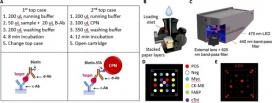Advances in a Highly Mobile and Cost-Effective Diagnostic Tool for Heart Health
Researchers are working on increasingly capable, affordable, and accessible tools for diagnosing cardiac conditions at the point of care. These efforts are supported by the NSF-funded Precise Advanced Technologies and Health Systems for Underserved Populations (PATHS-UP) Engineering Research Center, headquartered at Texas A&M University (TAMU), as part of its mission to change the paradigm for the health of underserved populations.
One of the approaches PATHS-UP is pursuing to achieve its mission is developing low-cost and compact read-out devices to diagnose cardiovascular diseases, a leading cause of mortality worldwide. Chronic diseases are particularly devastating in underserved communities in the United States, where they are contracted at a higher rate than the national average and are a major cause of death, disability, secondary complications, poor quality of life, and high healthcare costs. Many current diagnostic services are in centralized locations and use large-scale and expensive diagnostic equipment, limiting access for many. This PATHS-UP research is overcoming such barriers, making use of cost-effective hand-held devices to read test data and offering better precision and speed of diagnostic test results.
C-Reactive Protein (CRP) is a common marker of inflammation and risk of coronary artery disease. While high-sensitivity CRP tests are routinely used in clinics, they require expensive diagnostic equipment and complicated protocols that have the effect of limiting testing in underserved and remote regions with limited resources. In recent years, many commercial products with a smaller footprint and easier operation protocols for multi-marker detection have been developed, but many use either expensive benchtop readers (thousands of US dollars), require costly disposable cartridges (hundreds of US dollars), or are limited to few cardiac markers, preventing widespread use in point-of-care settings.



